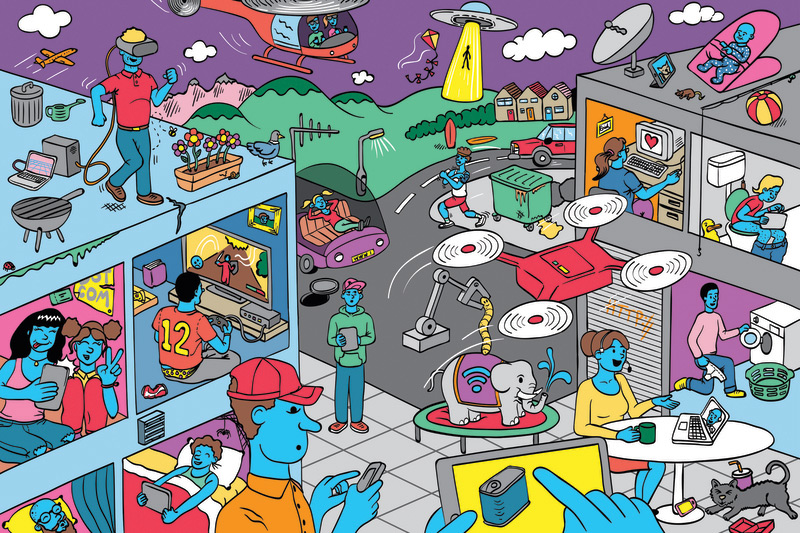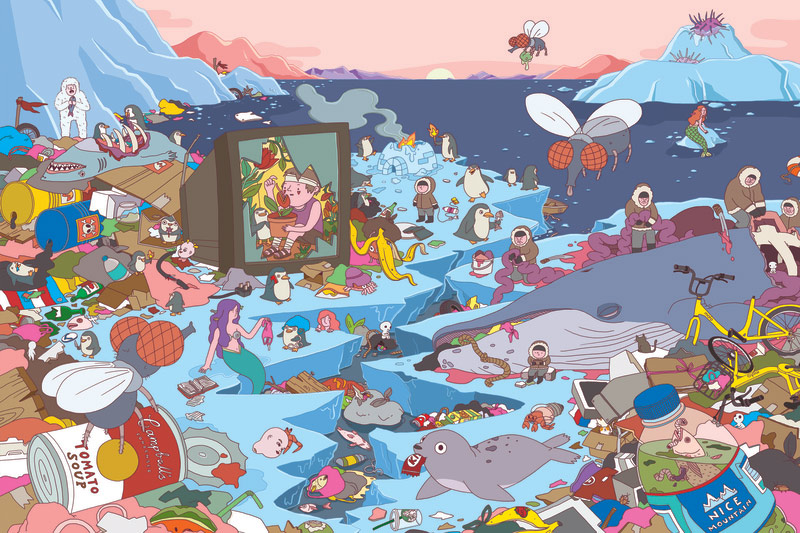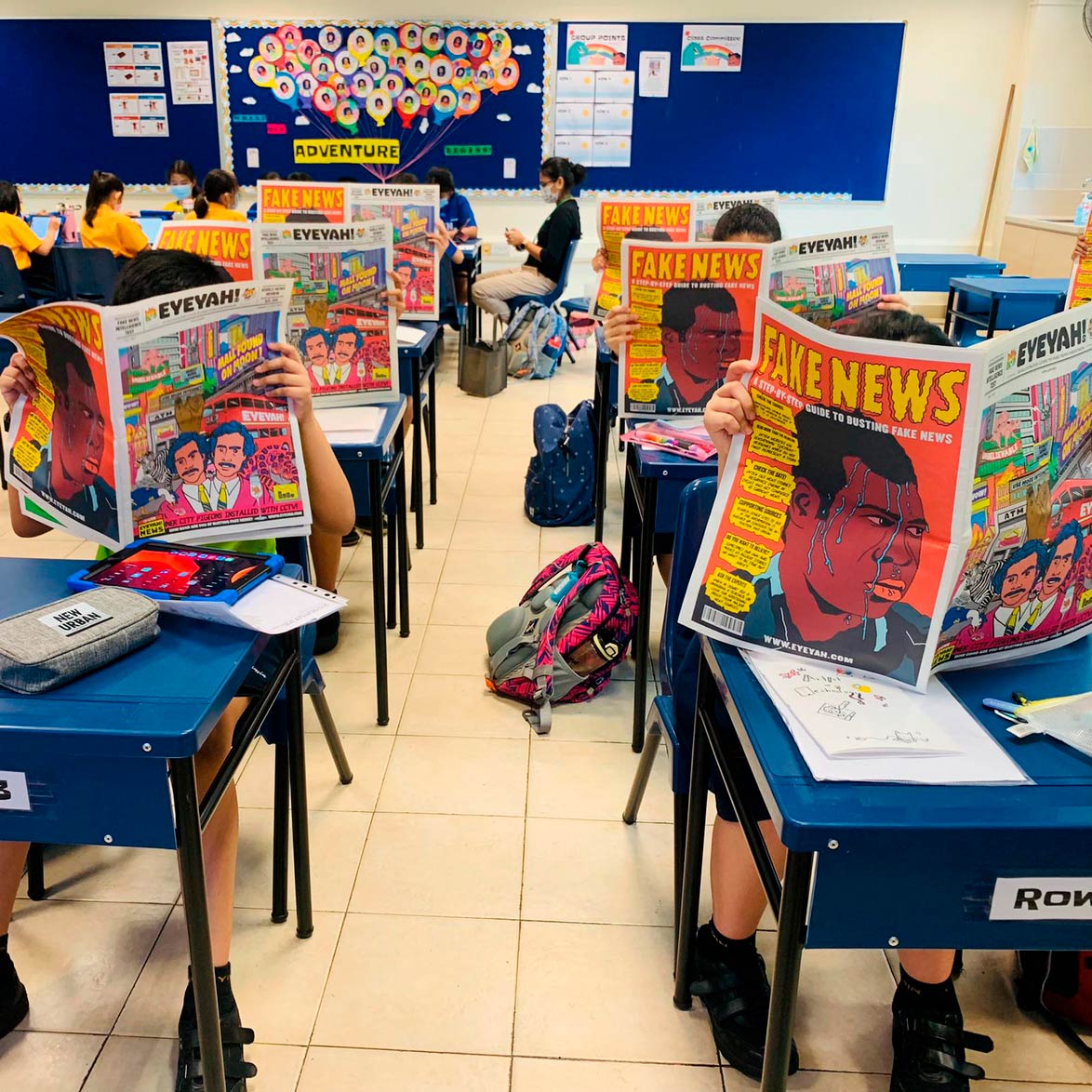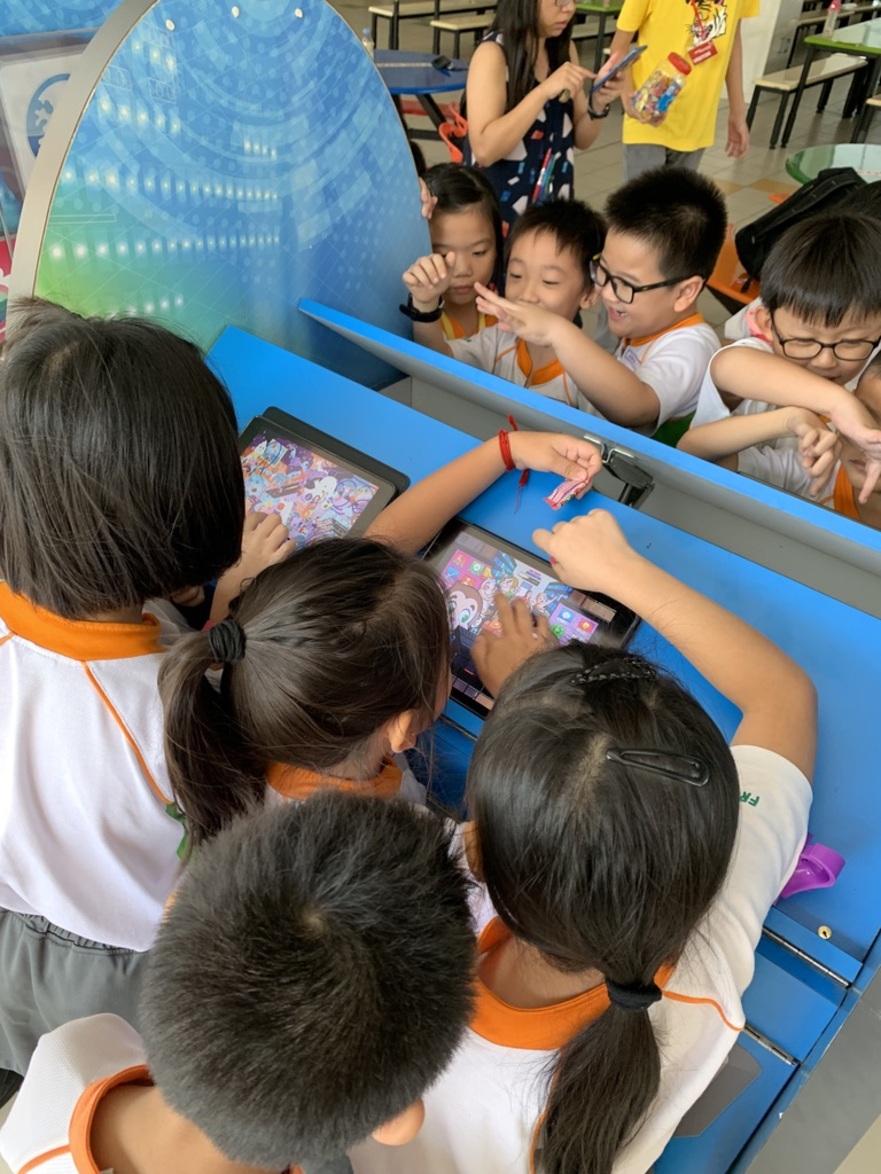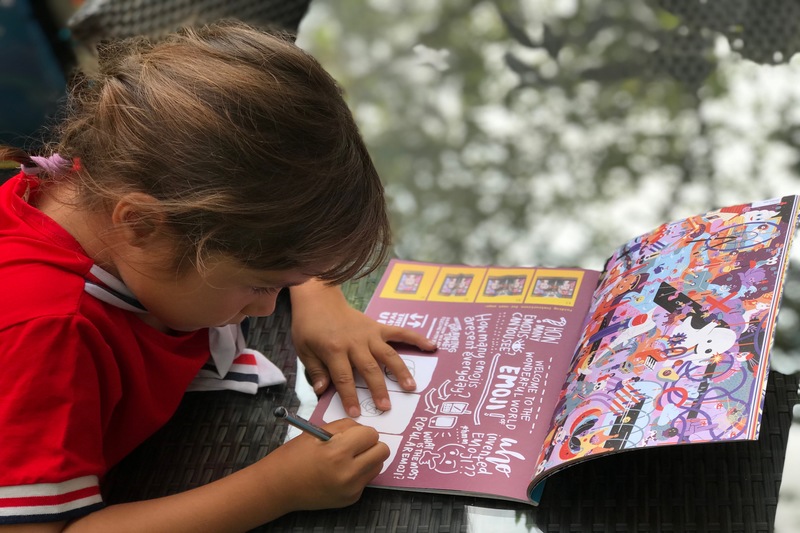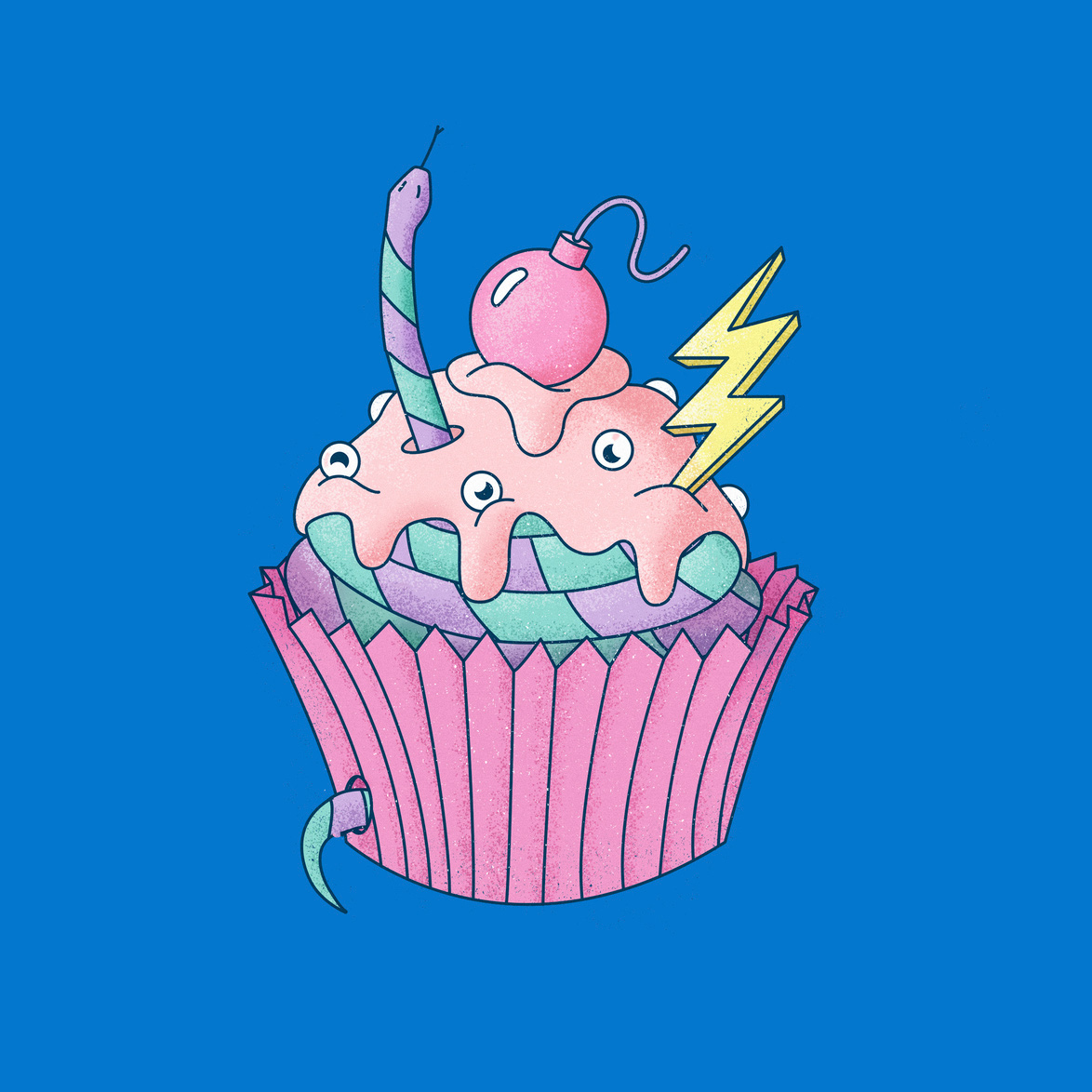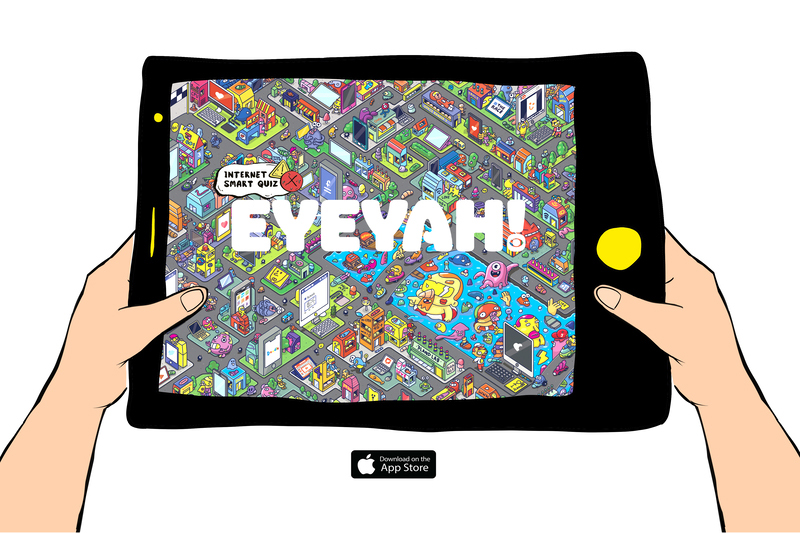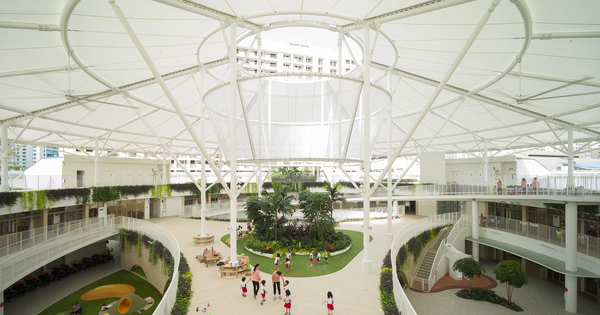DESIGN OF THE YEAR 2020
EYEYAH!
Designer
EYEYAH!
CONTACT
[email protected]
Climate change, fake news and food security are complex topics that stump even adults. But EYEYAH! makes them palatable and engaging for children. The educational platform uses visual communications to break down social issues that make audiences pause, ponder and perhaps push themselves to change for the better.
These are presented in a variety of multimedia offerings, ranging from magazines to exhibitions and even an augmented reality experience. Each is a product of intensive research with different experts, educators and parents. The Singapore-based team then collaborates with creatives from around the world to present it in visual form. The myriad touchpoints and experiences offer a global perspective on social issues while nurturing creative thinking through visible thinking routines such as “See, Think, Wonder.” EYEYAH! magazines are distributed globally in institutions like the Design Museum in London, Magma UK and National Gallery Singapore.
By using colourful and diverse visual languages and styles, EYEYAH! helps the young look at the world with fresh eyes and step up to be part of the change they want to see. It is a powerful example of how visual communications can not only captivate, but also educate.
About the Designer
Born in Singapore, EYEYAH! was created by Tanya Wilson and Steve Lawler, veterans of the creative industry. Over the last 20 years, the duo have worked with an impressive list of clients from around the world as well as a network of artists in both the commercial and cultural sectors.
Having created a name for themselves with the seminal kult Magazine in the early 2000s, they went on to develop a strong network of creators for the educational space through EYEYAH!. They firmly believe that designers and artists have incredible potential for changing the status quo and should be encouraged to do so.
A graduate of the prestigious FABRICA, a communication research centre in Italy, Steve’s artistic sensibility brings an utterly original curation to the platform that appeals to both children and adults. He is also an artist, designer, curator and creative director. Tanya’s background in public relations, events and communication has brought her around the world to execute fascinating projects for leading global brands. Often referred to as “the sensible one” in the partnership, her Masters in Digital Marketing makes her key in the strategic growth of EYEYAH! and its future.
DESIGNER
EYEYAH!
Tanya Wilson
Steve Lawler
DESIGNER
EYEYAH!
Tanya Wilson
Steve Lawler
1ENGAGING AND EDUCATIONAL
From food to the internet, each edition of EYEYAH! tackles issues in a visually exciting and accessible manner to effect change among its readers.
(Photo by Steve Lawler)2ENGAGING AND EDUCATIONAL
From food to the internet, each edition of EYEYAH! tackles issues in a visually exciting and accessible manner to effect change among its readers.
(Photo by Steve Lawler)3VISUAL TRICKS
Based on the learning pedagogy of “See, Think, Wonder”, EYEYAH! employs a variety of methods to educate its readers. For instance, this illustration by Matt C Stokes on a future powered by devices is hidden with surprises and meanings to train observation skills.
(Photo by Matt C Stokes)4EYE ON SOCIETY
The educational platform uses a visual approach to deconstruct social issues and develop creative thinking. For the issue on Trash , Singapore illustrator Ann Gee Neo was commissioned to highlight its impact on the Arctic.
(Photo by Ann Gee Neo)5KIDS LOVE IT
Since its launch in 2019, many children have encountered the educational platform through its print editions as well as exhibitions. Its worksheets have also been featured in the South China Morning Post’s educational newspaper, Posties, in Hong Kong.
(Photo by Yumin Primary)6KIDS LOVE IT
Since its launch in 2019, many children have encountered the educational platform through its print editions as well as exhibitions. Its worksheets have also been featured in the South China Morning Post’s educational newspaper, Posties, in Hong Kong.
(Photo by EYEYAH!)7KIDS LOVE IT
Since its launch in 2019, many children have encountered the educational platform through its print editions as well as exhibitions. Its worksheets have also been featured in the South China Morning Post’s educational newspaper, Posties, in Hong Kong.
(Photo by EYEYAH!)8A GLOBAL PLATFORM
While based in Singapore, EYEYAH! features work by illustrators from around the world. They include the Brisbane-based YeahYeahChloe, Lilly Friedeberg from Düsseldorf and Singaporean Kristal Melson.
(Photo by YeahYeahChloe)9A GLOBAL PLATFORM
While based in Singapore, EYEYAH! features work by illustrators from around the world. They include the Brisbane-based YeahYeahChloe, Lilly Friedeberg from Düsseldorf and Singaporean Kristal Melson.
(Photo by Lilly Freideberg)10A GLOBAL PLATFORM
While based in Singapore, EYEYAH! features work by illustrators from around the world. They include the Brisbane-based YeahYeahChloe, Lilly Friedeberg from Düsseldorf and Singaporean Kristal Melson.
(Photo by Kristal Melson)11MULTIMEDIA EXPERIENCE
EYEYAH! is published in a variety of formats depending on the topic. For its Internet issue, it created an interactive iPad app that was listed by Apple as the top free app of the week when it was launched.
(Photo by EYEYAH!)12(L-R) Tanya Wilson and Steve Lawler
(Photo by Ivan Loh, pigscanfly photography)Insights from the Recipient
Steve Lawler (SL): We have always been trying to give exposure to emerging artists, illustrators and graphic designers in Singapore. Ten years ago, we started curating shows and magazines based on themes like trust, fear, animals and touched slightly on social issues. For example, an issue on depression was one of the most poignant and effective from our archive. It definitely laid the foundation for EYEYAH!. We were working with creatives who were very skilled at evoking emotions, creating messages or illustrating facts, but there were not enough people seeing kult. Even though we printed 10,000 copies, it was really a drop in the ocean, as it attracted a niche audience who were between the ages of 25 and 30. Most people are either interested in art or not by that age — it’s too late to convert them. We wanted to get audiences interested in art and design earlier on. It makes way more sense to get in early to effect any social change too.
Tanya Wilson (TW): We never set out to create a tool for schools. When we launched our first issue on the dangers of the internet as a fun project, we didn’t know where it would go. After the accompanying exhibition, we started seeing a following amongst art teachers who used the designs to teach their students about the internet. We realised we could use design to talk about complicated and sensitive topics such as mental wellness and digital literacy which some teachers don’t feel comfortable talking to kids about. Moreover, we found that many kids lose confidence in art and no longer consider themselves “creative” by the time they hit secondary school. Lastly, there are numerous social, environmental and economic world problems facing our children today. As veterans in the design and advertising industries, we are aware of the power of visual communications to impact behaviour and effect change.
TW: We initially wanted to call it Kaypoh, because we think of the platform as one about staying curious about the world. But we learnt that this Singlish term also has negative connotations of being nosy. Steve came up with “EYEYAH!”. It’s a play on the word ‘eye’ and the local exclamation ‘aiyah’.
SL: We had a list of hundreds of names. We wanted it to combine an element of vision, have a local colloquialism wrapped around it and sound unusual. It was quite a challenge! EYEYAH! is designed around a learning pedagogy that you describe as “See, Think, Wonder”.
TW: “See, Think, Wonder” is a visible thinking routine from the Harvard Graduate School of Education, which many art teachers are familiar with. Visuals are used as a trigger for discussion among students that are facilitated by teachers. Teachers can point to our illustration and ask, “What do you see? What do you think the artist is trying to say?”. We invite the students to look for hidden surprises and meanings in the illustrations to nurture their observation skills, which are a fundamental key to creativity. Some students are quite oblivious at first, but they get it once we start them on the process.
SL: Images can overcome language barriers and make difficult subjects appear more approachable. We work in media and have seen great visual manipulations, but they are typically used to sell. Can we apply the tricks of advertising for education? And push skilled image manipulators into a space where they can really make change? That’s what is exciting for us. We live in a world saturated by images, which begs the question of how we can create a space for people to actually look in such a noisy environment. The classroom is a great example. Teachers can ask the students to give titles for our illustrations as a creative exercise. For example, the first time they do this they might say something literal like “ice cream-looking earth”. When they do it again, they might come up with “vanilla apocalypse”. The answer gets more and more creative in a measurable sense. We are trying to build a creative muscle in our readers. If they work on a caption contest in every issue, they are going to get better and less fearful of saying something stupid — that is key for us.
TW: If it had just been a print magazine, it would not have survived. Magazines are good for raising a brand’s profile, but they are tough to distribute and sell. We are always trying to distribute our content via other media platforms. Our issue on fake news comes in the form of a newspaper, which is totally different from previous issues that came as magazines. We also did a collaboration with Kahoot!, a quiz platform that is huge in schools, to create a fake news quiz. I don’t think you can stick to one formula and expect it to always work.
SL: It is in our nature to experiment with different media and new technologies, and it helps us reach out to new audiences in this fragmented media landscape. Recently, we created an online exhibition for Singapore Art Week and invited the public to create stories using GIF stickers designed by artists. The interactive nature of the medium basically lowered the barrier to entry for the public to make art. Sometimes the ideas just jump out at us based on the illustration. Like this would look amazing on a T-shirt or GIF sticker or sculpture. The more we experiment with different media, the more we make these connections.
TW: A school used our materials to teach their students about social media. These children, who are eight or nine years old, are meeting strangers online and not aware that they may not be who they say they are. At the end of the lesson, the children were asked if they would remove strangers from their social media account and over 90 percent said yes. Awareness of the risks of social media also increased by 90 percent after children attended our workshop. It means that our work resulted in action.
SL: For me, that was the best evidence that EYEYAH! works. It is about action and recall. We feature good illustrations to make the information more memorable and to open doors for discussion, leveraging our expertise in marketing and communications to stimulate audiences.
Citation
Jury Citation
Nominator Citation
Adrian Lim
Executive Director
Media Literacy Council
EYEYAH! is an educational platform that uses engaging learning materials and events to help children understand important social, environmental and economic topics. Through its magazines, toolkits, interactive workshops, exhibitions and even an app, EYEYAH! nurtures children’s creative and problem-solving skills in a playful and original way.
Each issue is painstakingly researched in consultation with subject matter experts, educators and parents. For example, after learning that the perception of “ugly” food items contributed to food waste, EYEYAH! created a family of “ugly” vegetable characters to change minds. The augmented reality experience was showcased to thousands of children and families at Singapore’s ArtScience Museum.
EYEYAH! is used in various educational set-ups around the world. Numerous schools in Singapore, the United Kingdom and the United States use it as part of their teaching materials. Its worksheets are featured monthly on the South China Morning Post’s Posties, one of Hong Kong’s top educational newspapers. Apple also recognised the EYEYAH! App as the top free app of the week when it was launched.
The Jury commends EYEYAH! for using design in a humorous yet sophisticated way to help children learn about the world they live in. Though modest in scale, the project has huge potential for global impact.
EYEYAH! was a recipient of the Media Literacy Council’s second iteration of Better Internet x Youth Call-for-Proposals. Their project was an app version of its Internet issue, which has since been used in primary schools as part of a workshop to promote safer internet usage.
Its interactive designs have piqued students’ interest in the topic and the accompanying activities have helped them to learn how to navigate the digital world safely and responsibly.
We are glad to have worked with EYEYAH! to provide education on internet safety and media literacy. They have used design and technology to capture the attention of students and enhance their understanding of responsible internet usage.



